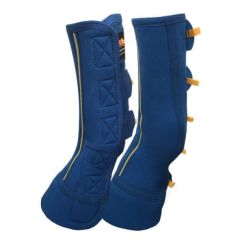Top tips for preventing mud fever
Weather forecast? Rain. Outlook for mud fever? Poor.
When the forecast predicts endless rain, it can only fill you with dread when you have a horse prone to mud fever. In our latest guest post, Candice Pottage, Senior Brand Manager at Equilibrium Products, looks at how muddy conditions can affect your horse and what you can do to help...

What is mud fever?
Mud fever generally arises during winter and early spring, causing painful sores and scabs, usually around the pastern and heel area, however it can also affect the upper legs and belly, and continue to cause problems all year.
What causes it?
Mud fever is the result of a skin infection caused by the bacteria entering the horse’s system and causing damage. Healthy skin normally acts as a barrier, however in wet and muddy conditions, the upper layer of skin can become compromised by the abrasion of soil grit on cold, wet skin. Continual damp conditions also cause this protective layer to break down, making it vulnerable to infection.
If left untreated, mud fever can become worse and the infection can spread further up the leg. Further damage to the open wounds may mean that they are difficult to heal and could lead to proud skin or even permanent loss of hair.
How do I prevent mud fever?
Good Paddock Management
- Avoid horses having to stand on muddy ground for too long.
- Rotate the use of your paddocks so they don’t become poached.
- Use electric fencing to prevent horses from standing in the deep mud that commonly collects in gateways.
Grooming
- Allow the mud to dry and then brush off with a soft bristled brush.
- If you must use a hose, gently dry the horse’s legs with a soft, clean, dry towel afterwards.
Mud Fever Care Products
- Barrier creams work by forming a protective layer between the leg and mud. A good quality nappy rash cream can work just as well and many experienced owners swear by them.
- Turnout chaps, such as Equilibrium Products Equi-Chaps Close Contact Chaps, help to keep your horse’s legs clean and dry. Close Contact Chaps encase the lower leg in breathable neoprene, fitting well down over the hoof and under the heel.
What should I do if my horse has mud fever?
If you suspect your horse has mud fever, it is important to keep him out of the wet and mud as much as possible.
Clean and dry the area thoroughly, then carefully clip the hair away from the infected area. Rub an antibacterial cream, such as Aniwell Filtabac, into the scabs to soften them and then gently remove loose ones. Once removed, liberally apply more antibacterial cream to the area and make sure you keep the skin clean and dry.
If symptoms don’t improve, or if you have any doubts, then consult your veterinary surgeon.
We have a range of products available to help minimise the impact of wet, muddy conditions. If you'd like to speak to one of our Supplement Specialists about your horse, please contact us.





